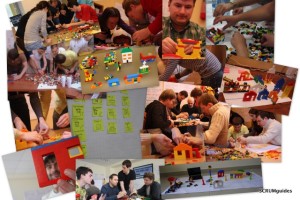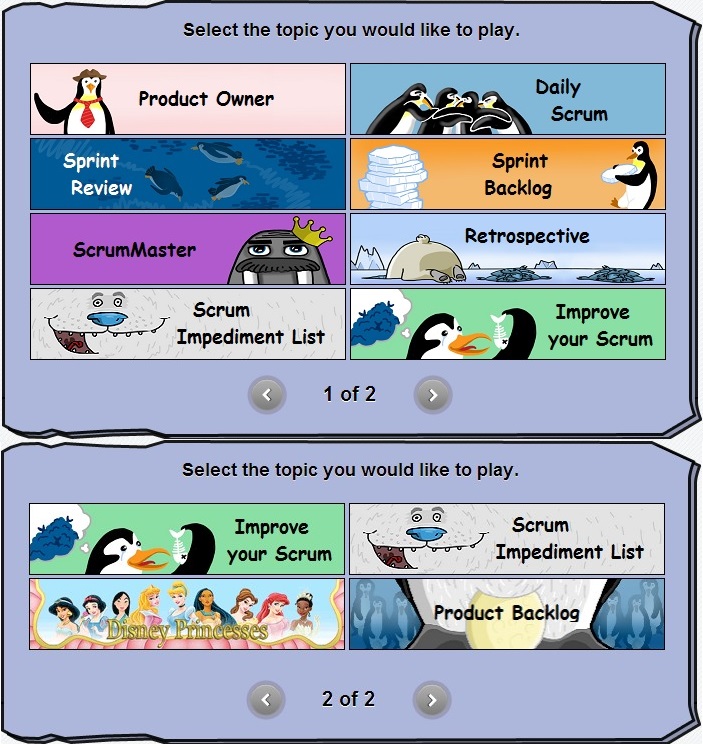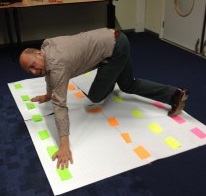Gamify Your Scrum Training and Build Team Synergy
Agile is all about team alignment, mindset sharing and streamlined, self-assessed work to bring about the best value possible to all stakeholders. This methodology is found in all kinds of Agile development, especially in the Scrum form. There are conventional teacher-centered processes to learn Scrum, but there are also hands-on opportunities to grasp this framework in a safe, game-like environment.
Besides, what is a better way to build team dynamics than playing a game together? The Agile Games and Play4Agile conferences particularly support this by encouraging the creation of games and dynamics for practicing the methodology.
Whether you are a Scrum trainer or a studio looking to get the team into the Agile mindset, here are 4 examples of what is out there that you can start implementing now.
Lego4Scrum
 Scrum trainer Alexey Krivitsky felt that there should be better Scrum simulations during classes, so he came up with Lego4Scrum – an approach where teams role-play and get hands-on product development within a space of 1:40 to 2 hours of play using Lego. The trainer is the Product Owner and another instructor or a selected member in each team can play the Scrum Master, but the game can be played without this role.
Scrum trainer Alexey Krivitsky felt that there should be better Scrum simulations during classes, so he came up with Lego4Scrum – an approach where teams role-play and get hands-on product development within a space of 1:40 to 2 hours of play using Lego. The trainer is the Product Owner and another instructor or a selected member in each team can play the Scrum Master, but the game can be played without this role.
The game is suited for classes of about 20 people (requires 1 Lego box per team), the objective is to create a Lego city.
The Product Owner’s role is to express how they usually behave and what kind of things they require and expect from the team members. Scrum Masters are there as skillful facilitators, and Testers are encouraged to participate in the building process for the sake of the game.
The game starts with the class divided into teams. The backlog is open, encouraging collaboration between the Product Owner and the team right off the bat. Mindful product development is practiced through a value-oriented backlog over a series of tasks to accomplish, and as any other game, the metrics collected (such as speed) are all about the teams creating ownership over their process.
“From my observations, certain behaviors people demonstrate in games are projections of working habits. And under stress people will tend to fall back to their natural behaviors,” says Alexey Krivitsky. Given that the behaviors, especially reactions to stress during the game might possibly hinder the actual application of Scrum, the trainer can address these with the team as they occur.
The Scrum Board Game
 The Scrum Game is a board game played by 2 to 6 people. The players make up the Scrum team and must work together in solving each other’s impediments and taking advantage of opportunities. The game simulates a fictitious sprint (what the backlog actually looks like is not discussed as the focus is in solving general process and stakeholder difficulties), and the objective is to burn down a certain amount of work before the 10th game day.
The Scrum Game is a board game played by 2 to 6 people. The players make up the Scrum team and must work together in solving each other’s impediments and taking advantage of opportunities. The game simulates a fictitious sprint (what the backlog actually looks like is not discussed as the focus is in solving general process and stakeholder difficulties), and the objective is to burn down a certain amount of work before the 10th game day.
The focus lies in team discussion and agreement when faced with Opportunities, Impediments and Tool cards. When facing an Impediment, the player gets stuck, and a tool card must be chosen to convince the rest of the team that it will solve the impediment. In the case of Opportunity cards, an obstacle is presented, and the team has 5 minutes to agree on the best solution.
Hours burn up or down depending on where the players land, and the amount is dictated by dice rolls. The quantity of dice depends on the team’s success in agreeing on the resolution of the Opportunity scenarios.
This board game by Mountain Goat Software website is available for download here.
Scrum Knowsy
“Are you an aligned team or are you just individuals working at cross-purposes?” investigates the creator of this ssolution, James Coplien. Scrum Knowsy was born from questioning alignment within the team, if everybody was really sharing Kaizen mind instead of the Scrum “certificate” mind.
According to the creator, having a certificate does not guarantee that the team is going in the same direction, in fact they might even have different opinions about how Scrum should work.
Scrum Knowsy is about the team sharing the priorities in different Scrum aspects, not to match any official guideline, but to encourage critical thinking and finding what works best within the team’s situation.
When playing with a team, the objective is to be the best guesser on what the other’s opinions about an aspect of Scrum are.

 For the creator, internal alignment comes first and external alignment, second. So just after the team comes to a consensus through guessing each other’s opinions through the game, they can optionally compare them with the game’s “Oracles” – Jens Ostergaard, Jeff McKenna, Jeff Sutherland and James Coplien. One can also compare opinions in solo mode, choosing from the available topics.
For the creator, internal alignment comes first and external alignment, second. So just after the team comes to a consensus through guessing each other’s opinions through the game, they can optionally compare them with the game’s “Oracles” – Jens Ostergaard, Jeff McKenna, Jeff Sutherland and James Coplien. One can also compare opinions in solo mode, choosing from the available topics.
The Product Owner game (In development)
Product owners are the ones responsible for guiding the team’s efforts into work that adds real value – as such, they are key members in any Agile team. However, there are few resources available for them to further their technical mastery besides certifications and a couple of game-like solutions such as the Product Box© or Buy a feature©.
This inspired the development of The Product Owner Game, which is currently being crowdsourced and crowdfunded by the Agile community. The game aims to make product owners great all-around, grow and improve within this media where they can practice the balancing of variables such as stakeholder input, budget, scope and time constraints.
Now you have some ideas on how to take your Scrum training to the next level. Have you tried any of those or developed your own variations to suit your training? Let us know in the comments.









Excellent Article!!
I presented at Play4Agile14 another Product Owner Game, which I developed – the so called “Product Owner Challenge”. It is best suited in transitioning from Waterfall to Agile: http://bit.ly/POChallenge
And after practicing/training you may also use #agileleagues, it’s an open source tool to drive agile’s team behaviors, gamify your dev environment!
GetBadges seems to be missing from this list 😉
I strongly recommend the combination: Taiga https://taiga.io/ and GB https://getbadges.io – the best solution for scrum in my opinion!